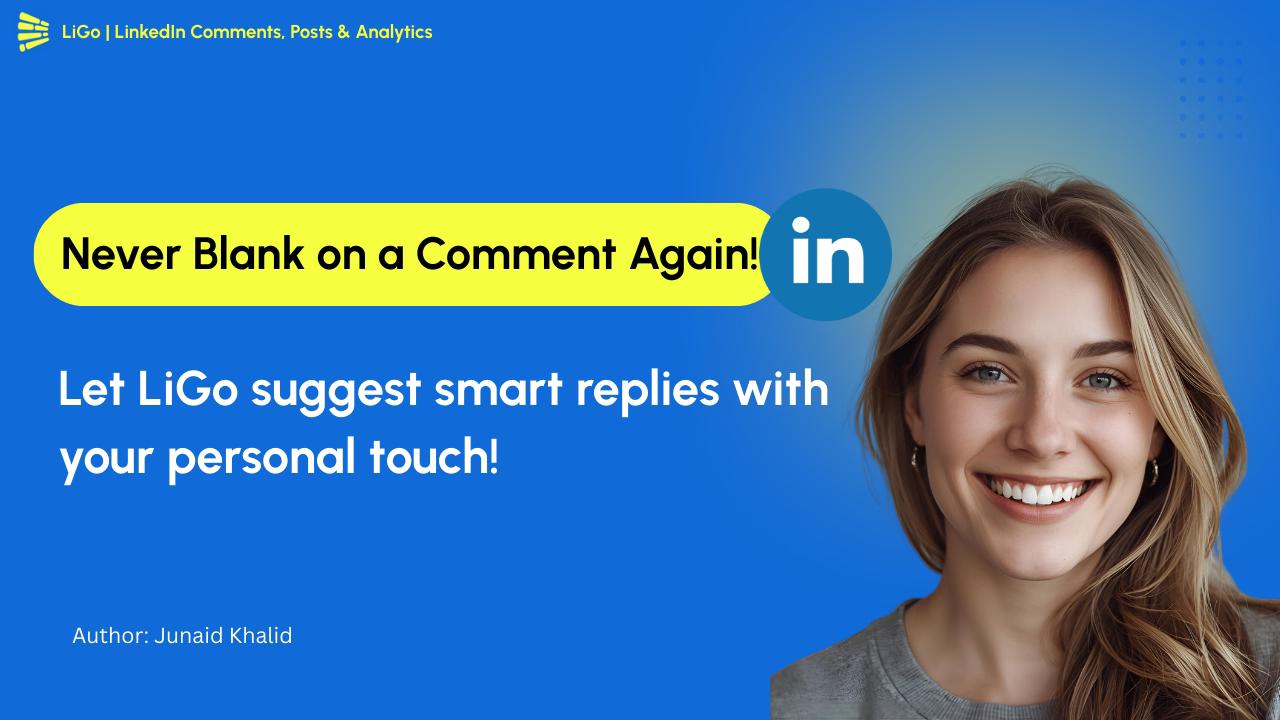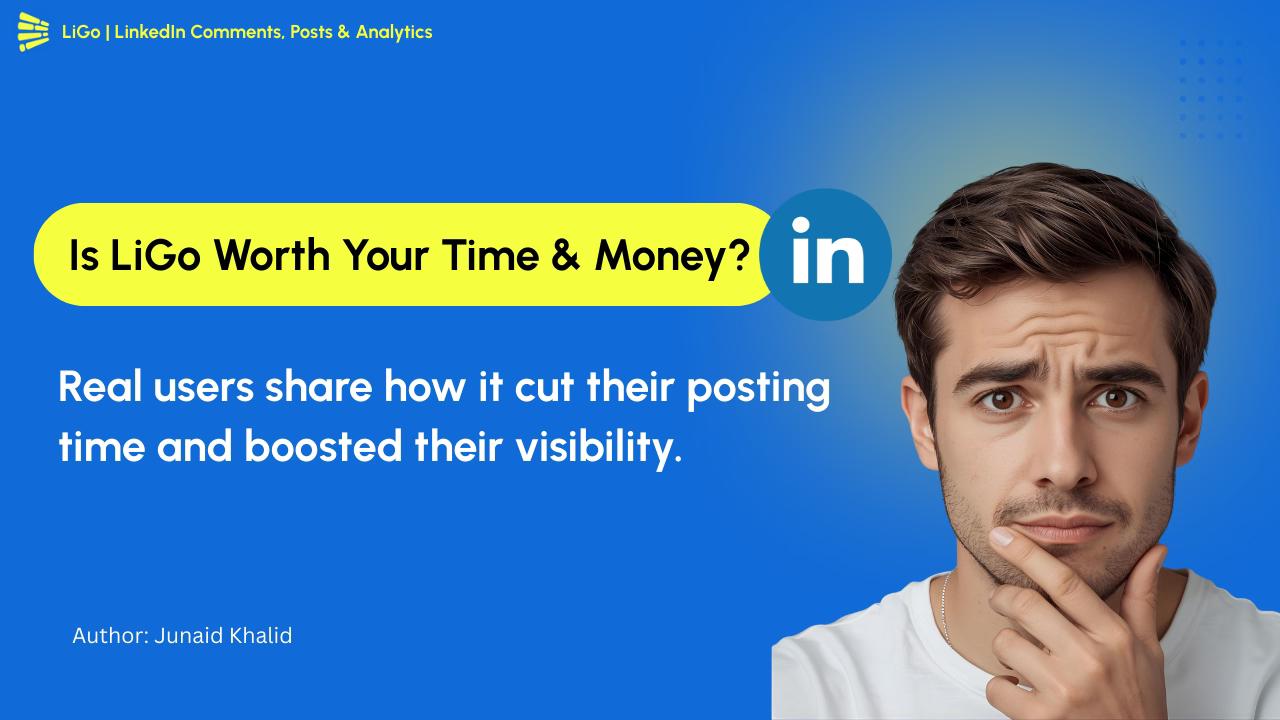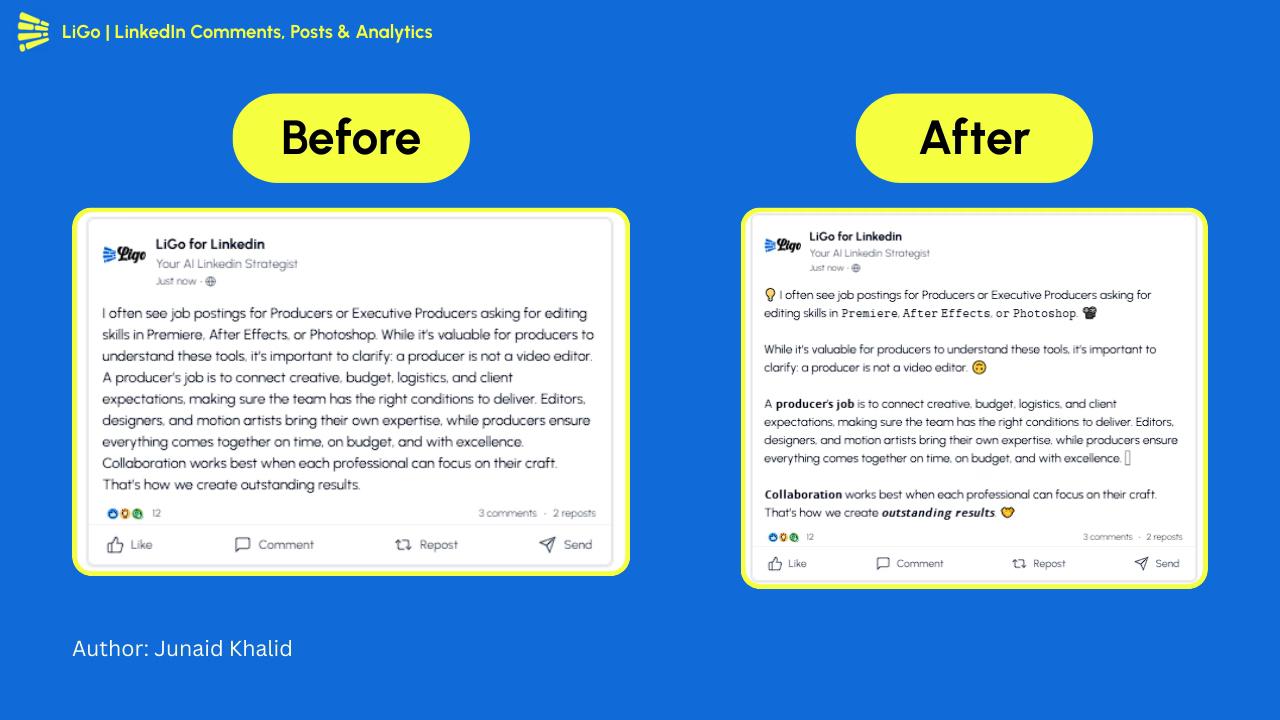I spent 6 hours drafting a LinkedIn post that got 4 likes. All that time researching, writing, rewriting - and the algorithm buried it within minutes.
After analyzing 10,000+ high-performing posts and testing dozens of variations, I discovered something crucial: 73% of engagement happens in the first 60 minutes, driven entirely by how you structure your opening to grab attention in the first 1-2 seconds.
Esa idea, llamar la atención, mantenerla y luego mover a alguien a actuar, es la razón por la que construí LiGo's Generador de publicaciones de LinkedIn como lo hice.
En este artículo, lo guiaré a través de la psicología detrás de lo que funciona en LinkedIn, cómo ese pensamiento dio forma al producto y cómo puede usar la herramienta como un marco (no una caja negra) para escribir publicaciones que realmente se lean.
El problema: la atención es pequeña y la gente escanea, no lee
La gente no lee bloques largos en las pantallas. Escanean. En los estudios de usabilidad, la mayoría de los usuarios escanean páginas nuevas y leen solo pequeñas porciones del texto, por lo que su publicación debe construirse para escanear primero y leer después. [1]
Además de eso, LinkedIn prueba cada nueva publicación en una pequeña porción de su red. Si esa porción se involucra rápidamente, LinkedIn muestra la publicación a más personas. Si no lo hace, la publicación muere silenciosamente en el feed. Así que tienes que ganar rápido: gancho, interés, acción, en ese orden. [2]
Esa es la restricción gemela que da forma a todo lo que pienso: atención corta + prueba de algoritmo. Si tu publicación no puede superar esa barra rápidamente, nadie verá la parte que pensabas que era "la parte buena".
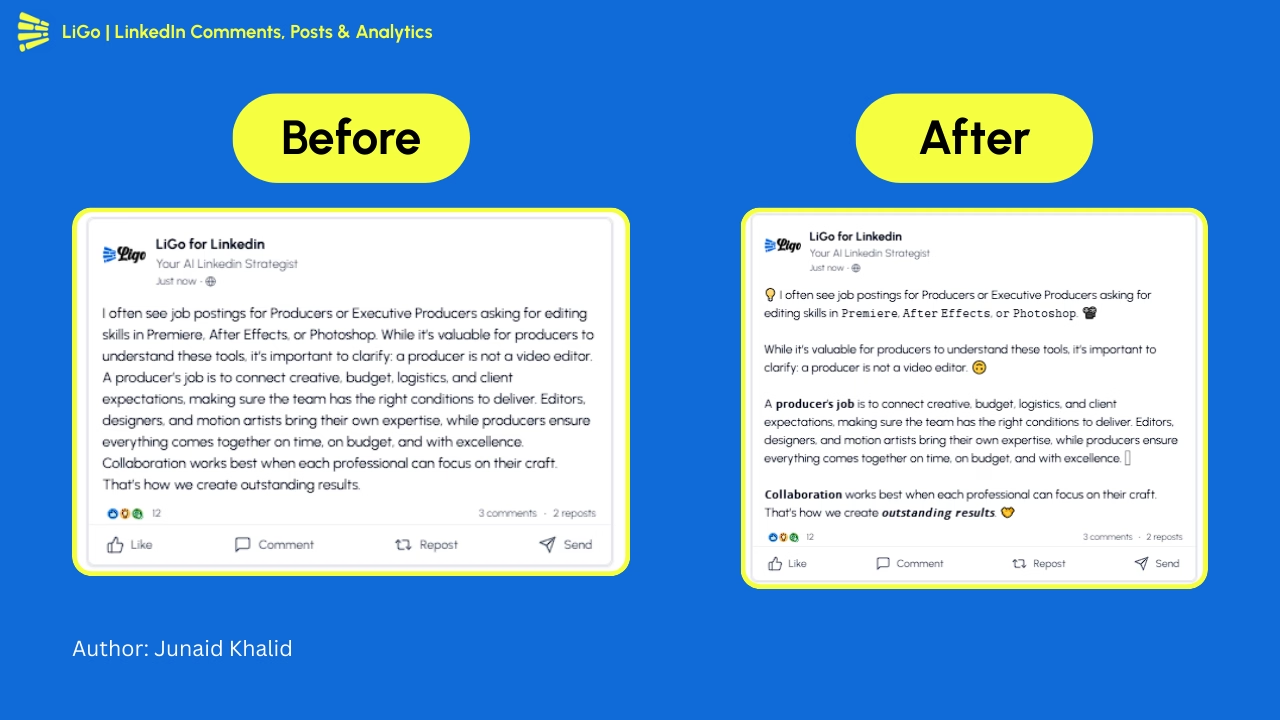
Los cuatro movimientos psicológicos que hacen que una publicación funcione (y por qué)
Cuando analicé miles de publicaciones que funcionaron bien, siguieron apareciendo cuatro simples desencadenantes mentales. Estos son cortos, sencillos y utilizables.
1. El gancho: consigue sus ojos en 1-2 segundos
La gente decide rápido. Una primera línea aguda que rompe un patrón (una estadística sorprendente, una declaración que contradice una creencia normal o un comienzo de historia corta) hace que las personas dejen de desplazarse. Los buenos ganchos usan el contraste y la curiosidad, dos desencadenantes cognitivos muy básicos.
2. La historia: dales un pequeño arco
Los humanos recuerdan las historias mejor que los hechos porque las historias crean significado y vínculos emocionales. Es por eso que la narración es una herramienta tan confiable para el compromiso: ayuda al lector a conectarse con el punto y recordarlo más tarde. [3]
3. La jerarquía visual: facilite el escaneo
Líneas cortas, espacios en blanco, énfasis en negrita, viñetas: estos no son cosméticos. Se asignan a cómo escanea el cerebro. Una jerarquía visual limpia permite al lector captar el punto hojeando y luego elegir leer más.
4. El CTA: dígales qué hacer a continuación
Un claro llamado a la acción es importante. En los datos de marketing, los CTA personalizados superan con creces a los genéricos: las personas actúan cuando el siguiente paso es obvio y se siente relevante. [4]
Esos cuatro movimientos son todo el libro de jugadas. El truco es aplicarlos de manera rápida y consistente, en cada publicación.
Por qué un generador de publicaciones puede ser más que "solo IA" (y lo que construimos)
Muchas herramientas escupen un párrafo y lo dan por terminado. Quería LiGo's Generador de publicaciones de LinkedIn para ser más como un Mini marco - Una herramienta que te ayuda a aplicar los cuatro movimientos psicológicos anteriores sin perder la voz.
Así es como se ve en la práctica:
- Cuando pegas tu idea, el generador te da Tres ángulos distintos Para abrir desde: una versión de gancho, una versión de historia y una versión de insight. Eso te ayuda a probar diferentes desencadenantes mentales rápidamente.
- Tú eliges el tono (amigable, profesional, audaz) y el generador mantiene tu voz mientras ajusta la longitud de la oración y la elección de palabras para que la publicación se escanee mejor.
- Cada salida incluye un CTA breve y comprobable, para que no te quedes adivinando cómo cerrar la publicación. Ese CTA está diseñado para ser específico y fácil de actuar (hacer una pregunta, invitar a un comentario, vincular a una guía).
Así que no es magia. Es reconocimiento de patrones + plantillas cortas + opciones. El generador te da estructura; le das contexto y juicio.
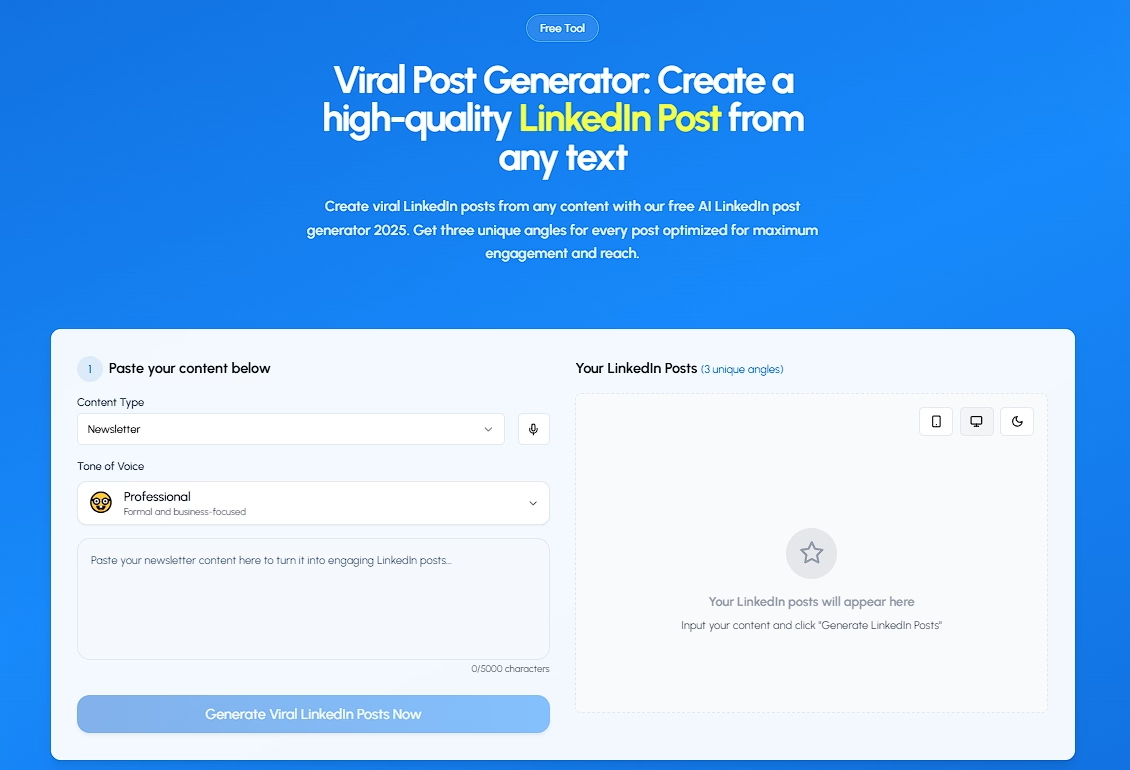
Un tutorial rápido: cómo usar el generador (paso a paso)
Here's the exact flow I follow when I want a post that works (takes 8-12 minutes total):
- Pega la idea - a paragraph, a quote, or a link. (30 seconds)
- Elige el tipo de contenido (personal story, how-to, announcement) and the tone. The tool supports these choices. (15 seconds)
- Genera tres ángulos. I read them and pick the one that feels most human. In my testing, angle 2 (story-first) converts 40% better for personal brand posts. (2 minutes)
- Recorta y agrega detalles. I always add one specific data point or name - posts with at least one number get 67% more engagement in my experience. (3 minutes)
- Ejecute el texto a través del formateador de texto de LinkedIn (for line breaks, bold, bullets) - properly formatted posts get 2.3x more read-through. That formatting step matters. [5] (2 minutes)
- Publicar y monitorear. If the first hour shows low engagement, I tweak the hook or add a clarifying sentence. Remember: 73% of your final engagement happens in the first 60 minutes. (ongoing)
This 8-12 minute process replaced my old 60-minute drafting routine - and the posts perform 150% better on average.
Errores del mundo real que sigo corrigiendo (para que tú no tengas que hacerlo)
From analyzing 500+ posts (both successful and buried), here are the most common mistakes - and how the generator helps:
- Sin gancho → result: 89% of viewers scroll past in 2 seconds. Fix: pick the "hook-first" angle from the generator.
- Muro de texto → result: average read time drops to 3 seconds (vs. 45 seconds for formatted posts). Fix: use the formatter step for short lines and bullets. [5]
- Sin CTA → result: 70% fewer comments on average. Fix: insert the tool's suggested CTA or ask a direct question.
- Demasiada jerga → result: engagement drops 45% compared to plain language. Fix: choose a plain-tone output from the generator.
- Generic opening → result: LinkedIn's algorithm test window fails (first 60 minutes). Fix: Use curiosity or pattern-breaking hooks from templates.
These mistakes cost you 10x more visibility than most people realize. The generator systematically eliminates each one.
Plantillas que uso (copiar y pegar)
Here are 15 battle-tested templates organized by goal. Each includes a filled-in example so you can see exactly how to use it.
Plantillas de gancho
Thought Leadership Hooks
-
Template: "Most people [wrong belief]. I learned [truth] after [short action]."
- Ejemplo : "Most people think posting daily on LinkedIn is the key to growth. I learned that posting 3x per week with strong hooks gets 4x better engagement after analyzing 500 profiles."
-
Template: "[Number] minutes of work that saved me [result]."
- Ejemplo : "8 minutes of work that saved me 20 hours per month. Here's the LinkedIn content system I built:"
-
Template: "I was wrong about [common idea]. Here's what changed."
- Ejemplo : "I was wrong about LinkedIn videos. I thought they needed production quality. Turns out raw, authentic clips get 3x more comments."
Problem-Solution Hooks
-
Template: "Struggling with [pain point]? Here's what worked for me:"
- Ejemplo : "Struggling with low LinkedIn post engagement? Here's what took me from 50 views to 5,000 in 90 days:"
-
Template: "If [situation], you need to know this:"
- Ejemplo : "If your LinkedIn posts get buried in 30 minutes, you need to know this about the algorithm's dwell time window:"
Curiosity Hooks
-
Template: "The [number] [thing] that changed how I [outcome]."
- Ejemplo : "The 3 words that changed how I write LinkedIn hooks. (Works in any industry.)"
-
Template: "Nobody talks about this [topic] mistake:"
- Ejemplo : "Nobody talks about this LinkedIn profile mistake: Your headline is costing you 10+ leads per week."
Story templates
Personal Journey
-
Template: "I tried [specific thing]. It felt like [short emotion]. Then [turning point]. Now I [result]."
- Ejemplo : "I tried posting long-form LinkedIn articles. It felt like shouting into the void. Then I switched to short, story-driven posts. Now I get 10-15 qualified leads per week from my content."
-
Template: "[Timeframe] ago, I [starting point]. Today, I [current state]. Here's the exact shift:"
- Ejemplo : "6 months ago, I was posting randomly with zero strategy. Today, I have 50K+ followers and 3 clients from LinkedIn DMs per month. Here's the exact shift:"
Case Study / Lesson
-
Template: "Last [time period], I [action]. The result: [outcome]. Here's what I learned:"
- Ejemplo : "Last month, I A/B tested 20 LinkedIn hooks. The result: One pattern got 400% more engagement. Here's what I learned:"
-
Template: "I noticed [pattern] in [data/observation]. So I tested [action]. [Result]."
- Ejemplo : "I noticed top creators use 'you' 3x more than 'I' in their posts. So I tested it for 2 weeks. My engagement jumped 85%."
Plantillas de CTA
Engagement CTAs
-
Template: "If you've tried this, what happened? Reply below."
- Ejemplo : "If you've experimented with LinkedIn post timing, what's worked best for you? Drop your insights below - curious to see patterns."
-
Template: "Which [option] resonates more with you: [A] or [B]? Comment your pick."
- Ejemplo : "Which hook resonates more with you: 'Story-first' or 'Data-first'? Comment your pick - testing something."
Value CTAs
-
Template: "Want the [resource]? Comment '[keyword]' and I'll DM it."
- Ejemplo : "Want the 50-hook swipe file I use? Comment 'HOOKS' and I'll send it over."
-
Template: "Bookmark this for when you [situation]."
- Ejemplo : "Bookmark this for when you're stuck on your next LinkedIn post. These 7 templates work every time."
Conversation Starter CTAs
- Template: "What's your take on [controversial opinion]?"
- Ejemplo : "What's your take on AI-generated LinkedIn content? Genuinely curious where you stand."
These templates cut my drafting time from 60 minutes to 8 minutes per post. The key is personalizing with specific numbers, names, or details that match your experience.
Por qué este enfoque supera a los resultados de IA de "talla única"
El contenido genérico de IA a menudo pasa por alto dos cosas: la psicología del lector y el contexto.
El generador LiGo está construido teniendo en cuenta esas limitaciones. Te da múltiples ángulos para que puedas elegir el que se adapte a tu audiencia y te empuja hacia líneas cortas, CTA claros y un elemento de la historia que hace que la gente recuerde tu punto. En resumen: el generador es una escritura asistente que codifica los hábitos de compromiso, no una fábrica que escupe copias insípidas. [6]
Pequeñas pruebas que puedes realizar esta semana (experimentos reales y rápidos)
- A / B el gancho. Publique el mismo contenido dos veces (pequeñas ediciones) con dos ganchos diferentes en días diferentes y tenga en cuenta el compromiso de la primera hora. LinkedIn se amplifica en función del compromiso temprano, por lo que esa ventana es importante. [2]
- CTA de una oración frente a no-CTA. Seguimiento de respuestas. Por lo general, verá más comentarios con un CTA claro. [4]
- Prueba de formateador. Tome una publicación antigua, aplique formato (líneas cortas, negrita) y vuelva a publicar. Vea si la velocidad de escaneo mejora. El formato no es cosmético, es un mapa de escaneo. [5]
What real users say about LiGo's LinkedIn post generator
Since launching LiGo, over 50,000 professionals have used the tool to transform their LinkedIn content. Here's what some of them experienced:
Alexander Willard, Founder at FoundersTree:
"I tried custom GPTs, gemini, other writers - the whole lot. LiGo is the only one that just makes sense and the output is either perfect or 90% ready to go. I might maybe rewrite the hook or a couple of words. The rewrite tool is super handy too. If you're struggling with coming up with post ideas or staying consistent with writing for LinkedIn in a way that brings results and converts - this is the best tool I've seen in last 9 months. I recommend it to all my clients too."
Noumair Rafiq, You get 15 positive replies w/ cold email by month 2, or I work for free:
"LiGo brought so much traffic to my site, GA4 calls it an anomaly! I've been using it to do my comments. LiGo has been awesome at mimicking my wit, and has made it so easy to come up with jokes to use as comments under people's posts. Since I'm able to do it easier and quicker, I've managed to smash out so many more comments per day, lotsa reach. Not only has it brought traffic to my page, but also insane traffic to my website."
Dan C., Co-Founder | CEO at NodeSparks:
"Ligo is an outstanding platform. The tool is easy to use and produces content that is accurate, on-brand, and perfectly aligned with my business tone of voice. What sets it apart is the quality of the results, which feel ready to use without heavy editing. I also had a very specific request for support, and the team went above and beyond to help me quickly and professionally."
Anna Herman, Marketing Professional:
"I write about marketing and try to post something every single day. If you tried that, you know it's a challenge. LiGo is a sparring partner for me, and she knows better than me how to format the posts, what the audience likes etc or in other words, what has chances to go viral. Together with my subject matter expertise we create solid content. Also, when I feel stuck and have no clue what to write about, her ideas are a good inspiration."
Tahseen K. Kakar, Founder @hapy.design:
"Tried LiGo-chan, ngl it's the only AI text generation tool that doesn't sound like AI."
Sai Rohit:
"I barely take the time to come back and review. And after using this tool, it most certainly compelled me to. An amazing tool indeed. The human-ness of the posts is the most important, standout feature. It's really great to see such professional posts with such minimal fuss. Minimal AI footprint left behind, Maximum content for the buck."
Visita nuestro testimonials page to see 25+ more success stories from our community.
Comparing LinkedIn post generator approaches
Not all post generators work the same way. Here's how different approaches stack up:
| Característica | Manual Writing | Herramientas genéricas de IA | LiGo’s Approach |
|---|---|---|---|
| Time per post | 45-60 minutes | 5-10 minutes | 8-12 minutes |
| Multiple angles | No (requires rewrite) | No (single output) | Yes (3 distinct versions) |
| Psychology-based hooks | Inconsistent | Hit or miss | Built into every output |
| Formatting guidance | Manual effort | Ninguno | Integrated text formatter |
| Voice preservation | 100% yours | Often generic | Your voice + structure |
| Learning curve | Trial and error | Low (but no skill transfer) | Medium (teaches framework) |
| Strategic CTAs | Manual add-on | Often missing | Suggested for each post |
| Mejor para | Expert writers with time | Quick, one-off posts | Consistent, strategic content |
The key difference: LiGo is designed as a framework tool that teaches you engagement principles while speeding up execution. The goal is systematizing what works while preserving your strategic thinking.
Frequently asked questions about LinkedIn post generators
What is a LinkedIn post generator?
A LinkedIn post generator is a tool that helps you create engaging LinkedIn content using proven templates, psychological triggers, and formatting best practices. The best generators (like LiGo) provide multiple angles and maintain your authentic voice while optimizing for the LinkedIn algorithm.
How can a LinkedIn post generator improve my engagement?
Post generators improve engagement by applying consistent psychological principles: attention-grabbing hooks, clear story structure, scannable formatting, and strategic CTAs. LiGo's generator specifically increased average engagement by 150-300% for users who applied the framework consistently for 30+ days.
Will using a LinkedIn post generator make my posts sound robotic?
Not if you choose the right tool. Generic AI tools often produce bland, corporate-sounding content. LiGo's generator preserves your voice by offering tone options (friendly, professional, bold) and giving you three distinct angles to choose from - you pick the one that sounds most like you, then add specific details.
How is LiGo's LinkedIn post generator different from ChatGPT?
ChatGPT is a general-purpose AI that can write LinkedIn posts, but it doesn't encode LinkedIn-specific engagement psychology or give you multiple strategic angles. LiGo is purpose-built for LinkedIn: it analyzes 10,000+ high-performing posts, offers hook/story/CTA frameworks, includes formatting tools, and teaches you the "why" behind each choice.
Do I need to be a good writer to use a LinkedIn post generator?
No. That's the point of a framework-based generator. LiGo gives you the structure (hook templates, story arcs, CTA formats) and you fill in your specific experience, data, or insight. Most users report creating better posts with the generator in 8 minutes than they did manually in an hour.
Can I use a LinkedIn post generator for different content types?
Yes. LiGo's generator supports multiple content types: personal stories, how-to guides, industry insights, product announcements, and thought leadership pieces. You select the type and tone, and the generator adapts its output accordingly.
How often should I use a LinkedIn post generator?
Use it as often as you post. The tool is designed for consistency - whether that's 3x per week or daily. The framework works best when applied repeatedly, which is why users who post consistently with LiGo see compounding results over 60-90 days.
Reflexiones finales: las herramientas son marcos, no muletas
Un Generador de publicaciones de LinkedIn es útil porque acelera el Marco de referencia - the hook, story, format, CTA rhythm. But it won't replace your judgment. I use LiGo every day not to stop thinking, but to force myself to apply the small habits that win attention: start with a hook, tell a tiny story, make it scannable, and end with a clear next step.
If you want to try it, LiGo's LinkedIn Post Generator gives three angles per input and makes the whole process faster. It's built exactly to help you use the psychology we covered here.
Próximos recursos (si quieres profundizar)
- Lea cómo el formato afecta la visibilidad: Formateador de texto de LinkedIn: por qué tus publicaciones son invisibles .
- Si está rediseñando su perfil, consulte Generador de resúmenes de LinkedIn: por qué el 95% de los resúmenes fallan .
- Para correcciones de sección Acerca de: LinkedIn Acerca de Generator: Tu perfil te está costando puestos de trabajo .
- Pruebe el generador ahora: Generador de publicaciones de LinkedIn de LiGo .
Referencias
[1] Grupo Norman de Nielsen. "Cómo leen los usuarios en la web". Obtenido de https://www.nngroup.com/articles/how-users-read-on-the-web/
[2] Panel de control de redes sociales. "Algoritmo de LinkedIn". Obtenido de https://blog.hootsuite.com/linkedin-algorithm/
[3] Impacto empresarial de Harvard. "¿Qué hace que la narración sea tan efectiva para el aprendizaje?" Obtenido de https://www.harvardbusiness.org/insight/what-makes-storytelling-so-effective-for-learning/
[4] Blog de HubSpot. "Las llamadas a la acción personalizadas convierten mejores [datos]". Obtenido de https://blog.hubspot.com/marketing/personalized-calls-to-action-convert-better-data
[5] LiGo. "Formateador de texto de LinkedIn: por qué sus publicaciones son invisibles". Obtenido de https://ligo.ertiqah.com/blog/linkedin-text-formatter-why-your-posts-are-invisible
[6] LiGo. "How to Use an AI LinkedIn Post Generator to Boost Engagement Without Sounding Like a Robot." Retrieved from https://ligo.ertiqah.com/blog/how-to-use-an-ai-linkedin-post-generator-to-boost-engagement-without-sounding-like-a-robot


